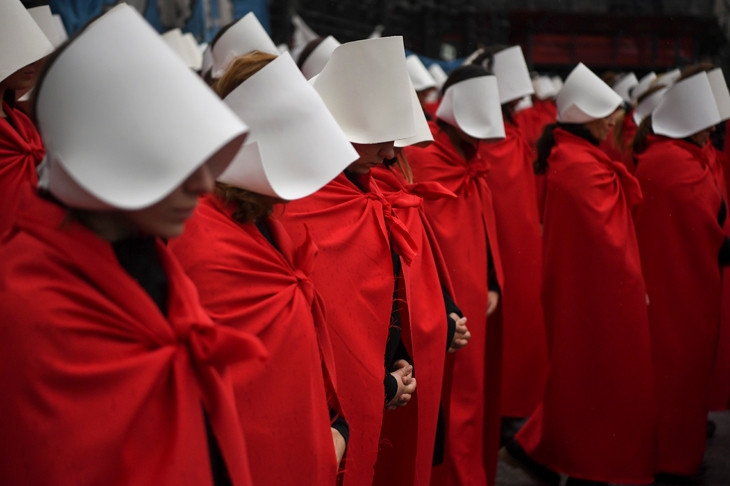Halloween used to be easy. It was a fancy-dress party: you could wear whatever you liked. The idea was to have fun.
As teens, my friends and I would dress up as ghouls, spiders or witches, with cones of black paper on our heads. When we became more mature, Halloween turned into a tarty affair. We thought this seemed authentic, somehow all-American. Our costumes became flimsier and more flammable. One girlfriend made a habit of always going dressed as ‘sexy cat’.
Inevitably, somebody would dress as a zombie Princess Diana or Amy Winehouse, or another celebrity who had died unpleasantly. The more risqué the better. I was once served a drink by a man with a toy doll tied to his lower half. He had come as Jimmy Savile.
But Halloween is changing. It is no longer a night of uncouth revelry. It has turned into an opportunity for political posturing, a moment to show that you understand what’s acceptable and what’s not. Now that the photos are online within hours, if not minutes, it is very important not to get it wrong.
Two years ago, Brexit costumes started to appear. Revellers wore mutilated EU flags or came as gravestones with ‘Brexit means Brexit’ as the epitaph. A more facetious take was the ‘plummeting pound’ costume.
Suddenly, you had to signal that you were on the right side of the argument. Donald Trump became the ultimate Halloween inspiration. People carved pumpkins into ‘Trumpkins’ with angry faces. Some orange face paint and a Make America Great Again cap, and you could dress as the President, just like every other person. Trump–related costumes have evolved quickly. You can now buy a ‘sexy anonymous op-ed costume’, inspired by that New York Times article written by one of the President’s staff.
Feminism has crashed the slutty party. Last year was the first #MeToo Halloween and skimpy costumes suddenly looked a bit dated. Was ‘sexy cat’ letting the sisterhood down? For a #MeToo-friendly Halloween, people felt obliged to go as a suffragette or a character from The Handmaid’s Tale, with a long red cloak and a white bonnet. The latter was both a literary and political statement. No wonder it became so popular.
Earlier this month, an online retailer began selling ‘sexy Handmaid’s Tale’ costumes, to see if there was demand for a more coquettish version. They were forced to stop because of the outcry. ‘There’s nothing sexy about oppressing women,’ said CNN, in its most stern voice.
These are choppy social waters. What is an appropriate ‘frightgeist’ costume? And more importantly, what isn’t? Last Halloween, a friend went dressed as Harvey Weinstein, complete with towelling dressing gown and an Oscar. He reasoned that it was the perfect look: what better way to display solidarity with the movement than by dressing up as the monster at the centre of it all? He misjudged the mood. A handmaid reprimanded him for ‘trivialising’ #MeToo. She asked him to remove his dressing gown — and, feeling the pressure, he did.
As each year passes, Halloween becomes a more frightening experience. Social media has made costume parties more prominent and therefore more terrifying than they once were. Costumes are rarely forgotten. One bad choice and the next thing you know, your picture is going viral, thanks to a post uploaded on to Instagram, which was picked up by a website that placed you no. 37 on their article ‘50 inappropriate Halloween costumes that just didn’t get the memo’.
How to get it right? The ideal woke costume needs to show you are clued up and have a keen sense of irony, but know where to draw the line. Why is it acceptable to go dressed as Trump — a man not exactly famed for his gracious behaviour towards women — but not Weinstein? Halloween is not the time to discuss such matters. You must just hope you don’t miscalculate.
The easiest blunder to make is ‘cultural appropriation’, which means borrowing from a culture that isn’t your own. Helpfully, there are plenty of lists online which detail what is and isn’t considered suitable. Every year, new costumes are added. Red Indians, geishas or Day of the Dead costumes have been verboten for a while. According to Bustle, a site for millennial women, ninjas, Egyptian queens and voodoo doctors also ‘reduce a culture to a costume’ so should be dodged. The site advises dressing as a ballerina, a box of popcorn or a hashtag, to avoid causing offence.
So, what to go as this year that is astute, culturally sensitive and still a little crass? Gareth Southgate, in an M&S waistcoat, would be safe. A troop of killer Saudis — complete with bone saws and some music to drown out the screaming — would seem apt for a carnival of horror, but dressing in a Middle Eastern outfit isn’t without risks.
Stormy Daniels or a pregnant Duchess of Sussex would be a classic choice; both just require some padding under your top. Melania Trump is another failsafe. The pith helmet and starched white linen shirt she wore in Africa would be relatively simple to copy, for a very 2018 Halloween look. Then again you may be accused — like she was — of dressing like a colonialist.
No doubt there will be some Russian assassins around, with natty bottles marked ‘Novichok’. But the safest option for scaredy cats is to go dressed as an inanimate object. This year, I might go as Salisbury Cathedral. The famous 123-metre spire can be made out of that old faithful, a cone of paper.
When did this all become so serious? Halloween was meant to be a tacky business; a silly American festival we knew was naff but loved anyway. Now it is a sartorial minefield where a faux pas can mean you are cast out like a witch. That really is spooky.







Comments